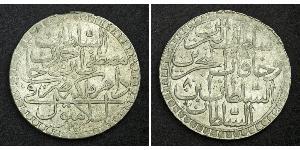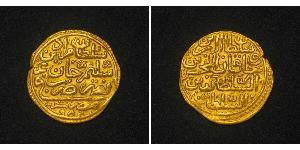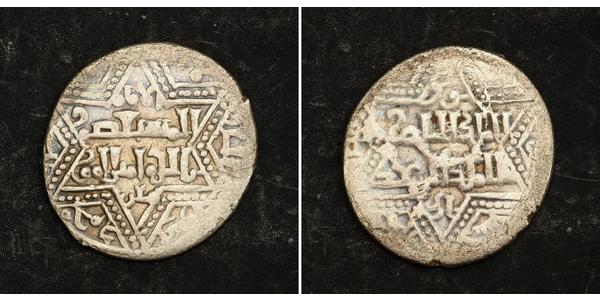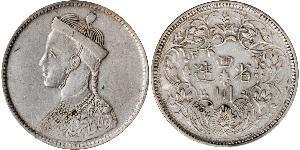(Verkauft für $7.0)
1260, Artuqids of Mardin, Najm al-Din Ghazi I. Silver ½ Dirham Coin. VF-
Mint Place: Mardin Denomination: ½ Dirham Mint Period: 1239-1260. Culture: Artuqids of Mardin Condition: Light marginal corrosion, toherwise VF. Ruler: Najm al-Din Ghazi I., al-Sa´id, 1239-1260 AD. Diameter: 20mm Weight: 2.56gm Material: Silver
Obverse: Inscription within six-spiked star. Reverse: Inscription within six-spiked star.
Traditionally, this obverse type has been thought to represent the mourning of Saladin, who died in AH 589, the year this coin was issued. Spengler and Sayles have argued that it depicts Virgo surrounded by planets, referring to an astrological event of AH 582 considered by many to signal an imminent calamity - one fulfilled by the death of the Ayyubid leader seven years later. Thus, they argue, the design still refer to Saladin's passing, but in a more complex way than conventionally thought.
The Artuqid dynasty (Artuklu in Turkish, sometimes also spelled as Artukid, Ortoqid or Ortokid; Turkish plural: Artukogullari) was an Oghuz Turkish dynasty that ruled in Eastern Anatolia, Northern Syria and Northern Iraq in the eleventh and twelfth centuries. Two main branches of the dynasty ruled from Hasankeyf (Hisn-i Keyf, Hisnkeyfa) between 1102–1231 and Mardin between 1106–1186 (and until 1409 as vassals). There was also a third branch that acquired Harput in 1112 and was independent between 1185–1233.
The dynasty was founded by Artuq, son of Eksük, a general originally under Malik Shah I and then under the Seljuk emir of Damascus, Tutush I. Tutush appointed Artuq governor of Jerusalem in 1086. Artuq died in 1091, and his sons Sokman and Ilghazi were expelled from Jerusalem by the Fatimid vizier al-Afdal Shahanshah in 1098; the Fatimids lost the city to the crusaders the following year.
Sokman and Ilghazi set themselves up in Diyarbakir, Mardin, and Hasankeyf in the Jezirah, where they came into conflict with the sultanate of Great Seljuk. Sokman, bey of Mardin, defeated the crusaders at the Battle of Harran in 1104. Ilghazi succeeded Sokman in Mardin and imposed his control over Aleppo at the request of the qadi Ibn al-Khashshab in 1118. In 1119 Ilgazi defeated the crusader Principality of Antioch at the Battle of Ager Sanguinis.
In 1121 a Seljuk-Artuqid alliance, commanded by Mehmed I of Great Seljuk and Ilghazi, was defeated by Georgia at the Battle of Didgori. Ilghazi died in 1122, and although his nephew Balak nominally controlled Aleppo, the city was really controlled by Ibn al-Khashshab. Al-Kashshab was assassinated in 1125, and Aleppo fell under the control of Zengi of Mosul. After the death of Balak, the Artuqids were split between Diyarbakir, Hasankeyf and Mardin. Sokman's son Davud, bey of Hasankeyf, died in 1144, and was succeeded by his son Kara Aslan. Kara Aslan allied with Joscelin II of Edessa against the Zengids, and while Joscelin was away in 1144, Zengi recaptured Edessa, the first of the Crusader states to fall (see Siege of Edessa). Hasankeyf became a vassal of Zengi as well.
Kara Aslan's son Nur ad-Din Muhammad allied with the Ayyubid sultan Saladin against the Sultan of Rum Kilij Arslan II, whose daughter had married Nur ad-Din Muhammad. In the peace settlement with Kilij Arslan, Saladin gained control of the Artuqid territory, even though the Artuqids were still technically vassals of Mosul, which Saladin did not yet control. With Artuqid support, however, Saladin eventually took control of Mosul as well.
The Artuklu dynasty remained in nominal command of upper Mesopotamia, but their power declined under Ayyubid rule. The Hasankeyf branch conquered Diyarbakir in 1198 and moved here, but was demolished by the Ayyubids in 1231 when it attempted to form an alliance with the Seljuks. The Harput branch was destroyed by the Sultanate of Rum due to following a slippery policy between the Ayyubids and Seljuks. The Mardin branch survived for longer, but as a vassal of the Ayyubids, Sultanate of Rum, Il-Khanate and the Timurids. Karakoyunlu captured Mardin and finally put an end to Artuklu rule in 1409.

|
Beigetragen von:
anonymous 2017-07-21 |

1 Kurush Osmanisches Reich (1299-1923) S ...
Diese Gruppe hat 4 Münzen / 3 Preise
Add coin to this group

1 Kurush Osmanisches Reich (1299-1923) S ...
Diese Gruppe hat 2 Münzen / 1 Preise
Add coin to this group

2 Zolota Osmanisches Reich (1299-1923) S ...
Diese Gruppe hat 13 Münzen / 10 Preise
Add coin to this group

1 AE2 Antikes Griechenland (1100BC-330) ...
Diese Gruppe hat 8 Münzen / 7 Preise
Add coin to this group

1 Altin Osmanisches Reich (1299-1923) Gold
Diese Gruppe hat 2 Münzen / 2 Preise
Add coin to this group
1\/2 Thaler
Diese Gruppe hat 2 Münzen / 1 Preise
⇑
8 Real Kaiserreich Mexiko (1821 - 1823) Silber
Diese Gruppe hat 11 Münzen / 10 Preise
⇑












-300-150-v98Kbzbi3foAAAFLtHfk0LdW.jpg)






